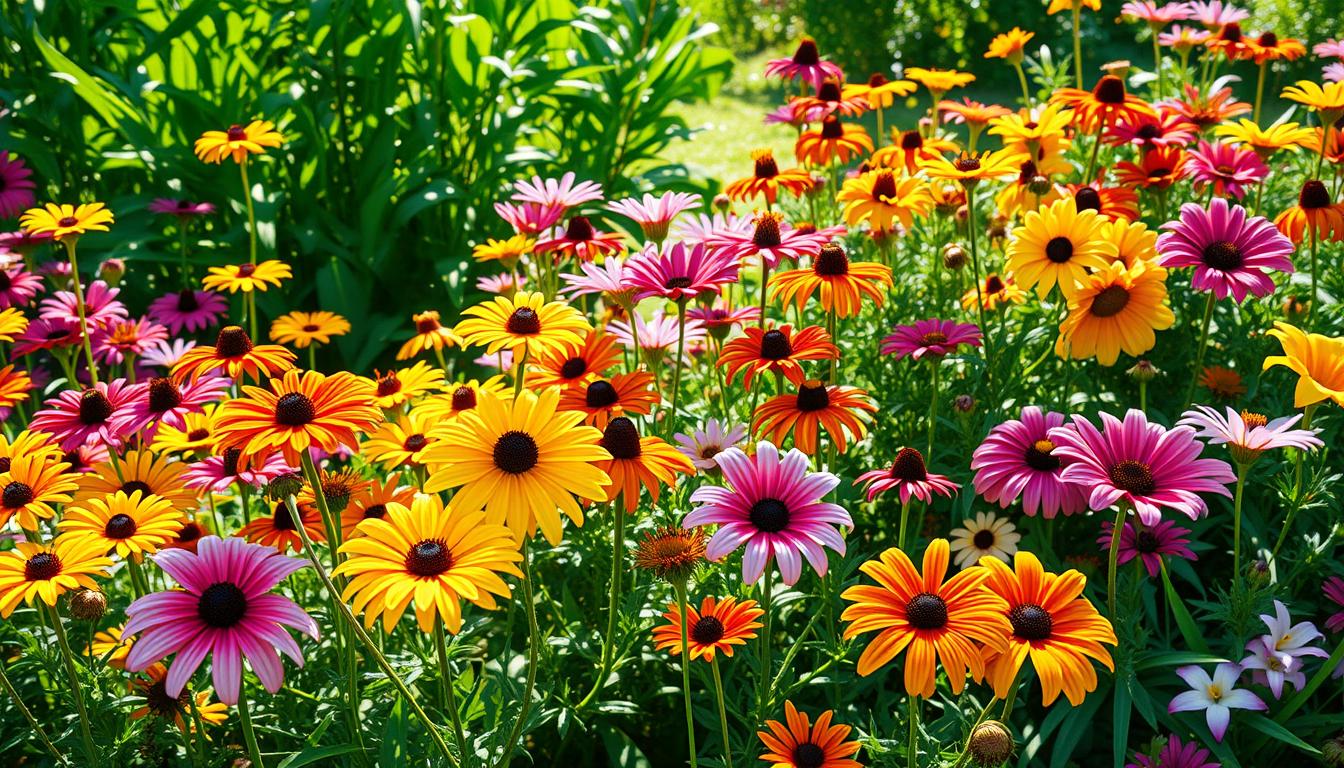I’m excited to share my knowledge on choosing and caring for perennial flowers that love full sun. These flowers are perfect for sunny spots because they’re easy to care for. They bloom beautifully all season, adding color to your garden.
When picking the best sun-loving perennial flowers, I look at how well they handle heat and dryness. I also consider if they attract pollinators and add color to my garden. These flowers are essential in my garden and have worked well for me.
In this article, I’ll share my tips for growing perennial flowers in full sun. I’ll cover how to care for them and which varieties do best. Whether you’re an experienced gardener or new to gardening, I hope to inspire you. I aim to help you create a stunning garden with perennial flowers that thrive in full sun.
Why Choose Perennial Flowers for Full Sun?
Choosing the right flowers is key in gardening. Perennial flowers for full sun are perfect for those who want vibrant colors and textures without replanting every year. They are also great for those who prefer easy gardening.
Benefits of Growing Perennials
Some benefits of growing perennials include:
- Year-round interest: Perennials offer a stunning display of colors and textures all season.
- Low maintenance: They are easy to care for, needing less work than annuals.
- Cost-effective: Since they come back year after year, you save money on replanting.
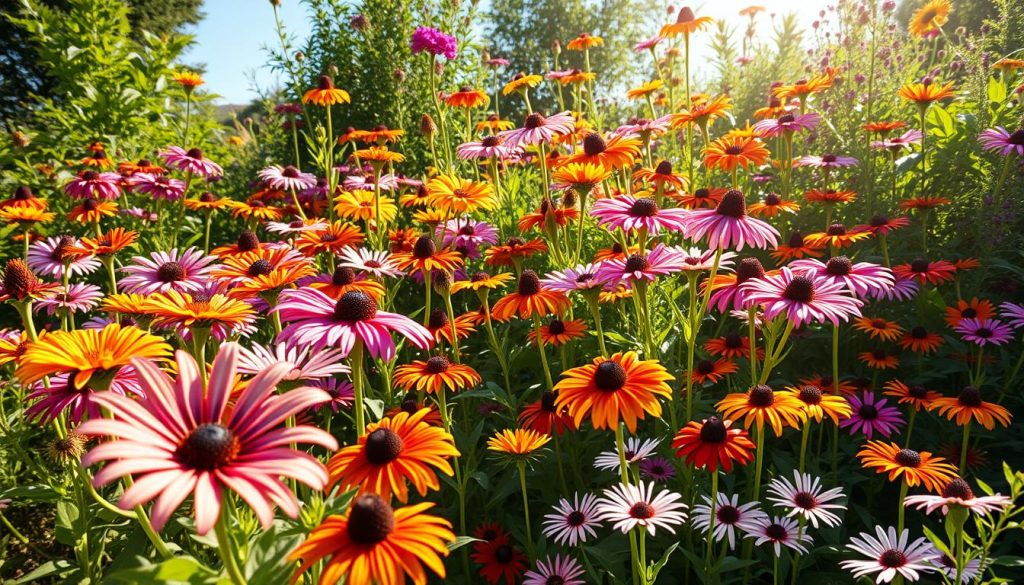
Long-Term Investment in Your Garden
Choosing the right perennials is a smart investment in your garden. With the right care, they can thrive for years. This brings beauty and joy to your family for a long time.
Best Perennial Flowers for Full Sun
Choosing the right perennial flowers is key for a beautiful garden in full sun. Colorful flowers can make your garden lively. Perennial flowers that love full sun ensure blooms all season.
Popular Choices for Sunny Gardens
Black-eyed Susans, coneflowers, and lavender are top picks for full sun gardens. They’re beautiful and easy to care for. Here are some favorites for sunny spots:
- Black-eyed Susans: These daisy-like flowers are a classic choice for full sun gardens and can bloom from June to September.
- Coneflowers: With their large, showy flowers, coneflowers are a great choice for adding color and texture to your garden.
- Lavender: This fragrant, purple flower is perfect for attracting pollinators and adding a soothing scent to your garden.
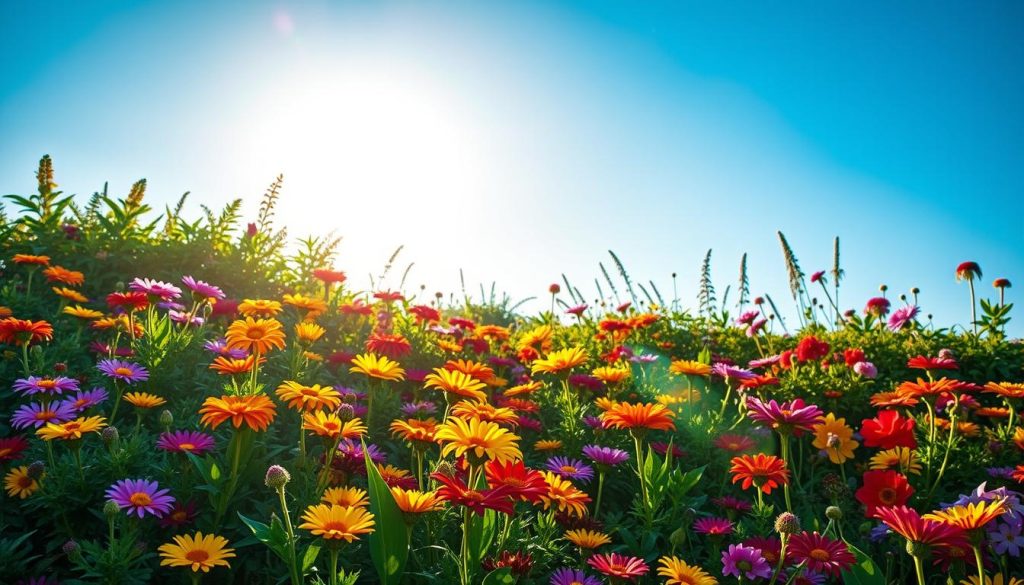
Unique Varieties to Consider
There are many unique perennial flowers that love full sun. Adding these to your garden can make it truly special. They offer a mix of colors and textures.
How to Choose the Right Perennial
Choosing the right perennial flowers for full sun is key to a beautiful garden. With many options, it can feel overwhelming. But, focusing on a few important factors can help you pick the best flowers.
Factors to Consider for Sun Exposure
First, think about how much sunlight your garden gets. If it’s in full sun most of the day, pick flowers that can handle the heat. Important things to look at include:
- Duration of sunlight
- Intensity of sunlight
- Soil type and moisture levels
Soil Type and Watering Needs
Soil type and how much water your plants need are also important. Flowers that don’t need much water do well in dry soil. Keep these in mind:
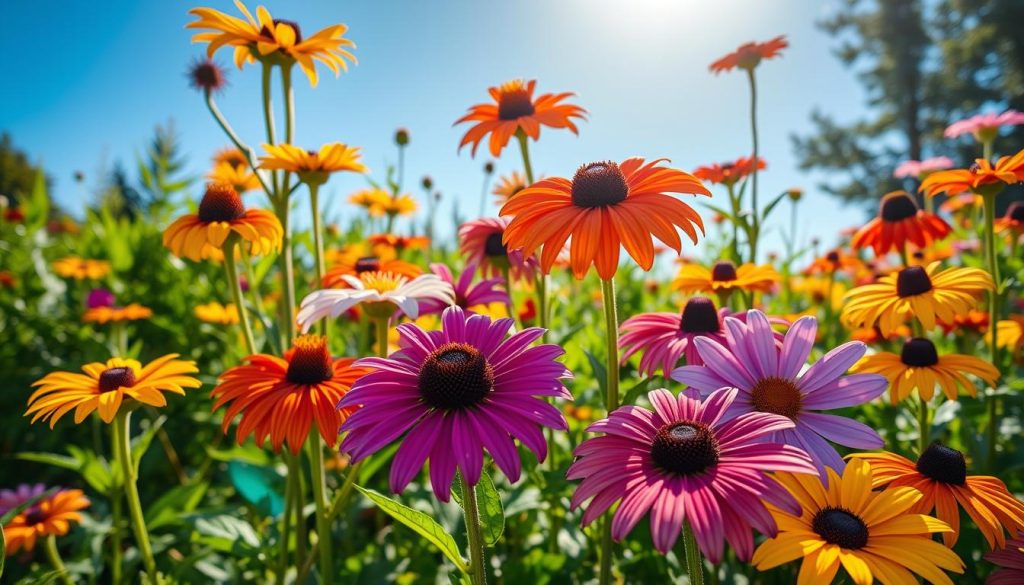
By thinking about these points, you can find the perfect flowers for full sun. This will make your garden both beautiful and easy to care for.
Planting Perennials: Timing and Techniques
Timing is key when planting perennial flowers for sunny spots. The best planting time varies by region and climate. Spring and fall are usually the best, with cooler weather and more moisture.
In areas with cold winters, plant in spring after the last frost. For places with milder winters, fall planting is better. This lets plants grow strong before summer. For sun-loving flowers like black-eyed susans and coneflowers, choose well-draining soil and full sun.
Best Times for Planting in the U.S.
- Spring: March to May, after the last frost
- Fall: September to November, before the first frost
Techniques for Successful Transplanting
For successful transplanting, handle plants carefully and avoid root disturbance. Plant at the same depth as in the pot and water well. Mulch helps keep moisture in and weeds out.
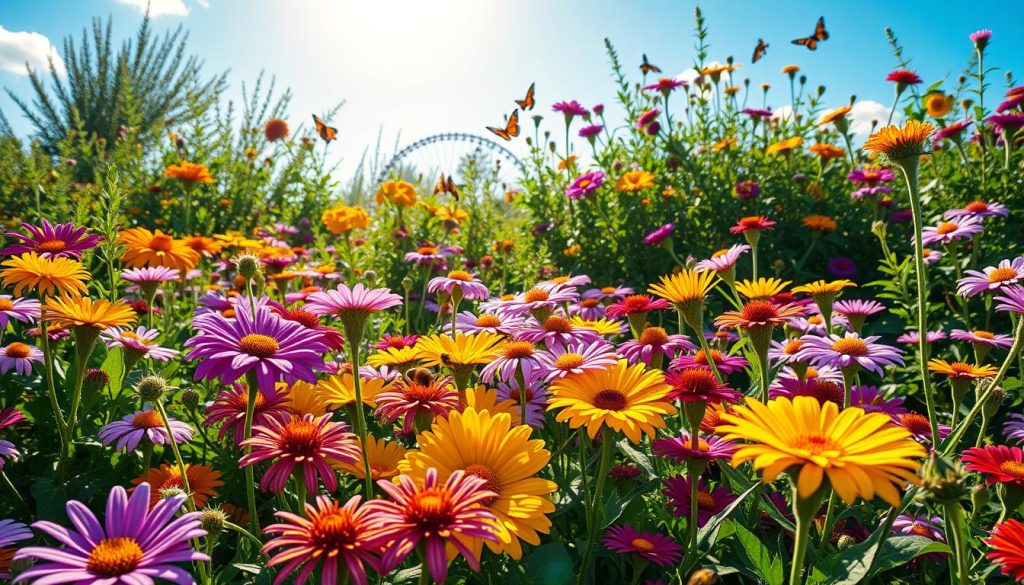
By using these tips, your garden will bloom with beautiful perennials. Choose the right plants for your area and climate. If you have questions, don’t hesitate to ask a gardening expert.
| Region | Best Time to Plant |
|---|---|
| Northeast | Spring: April to May |
| South | Fall: September to November |
| West Coast | Spring: March to May |
Care Tips for Sun-Loving Perennials
To keep my low-maintenance perennial flowers for full sun thriving, I focus on their care. These flowers need regular watering and fertilization. A good care plan ensures they bloom well and stay healthy.
Watering Schedule That Works
I water my sun-loving perennials deeply once or twice a week, based on the weather. This prevents overwatering, which harms them. Here are some tips for a good watering schedule:
- Check the soil moisture by inserting a finger into the soil up to the knuckle.
- Water deeply to encourage deep root growth.
- Avoid getting water on the leaves to prevent fungal diseases.
Fertilization: What, When, and How
Fertilizing my perennial flowers that thrive in full sun is key for their growth and blooming. I use a balanced fertilizer in the spring and a high-phosphorus fertilizer in the summer. Here’s a simple fertilization schedule:
| Time | Fertilizer |
|---|---|
| Spring | Balanced fertilizer (10-10-10) |
| Summer | High-phosphorus fertilizer (10-20-10) |
Designing a Full Sun Garden Bed
When planning a full sun garden bed, think about the layout and plant choices. A well-designed bed can show off colors and textures all season. Mixing plants like black-eyed susans and coneflowers can make a beautiful display.
Here are some layout ideas to make your garden bed stand out:
- Group plants with similar growth habits and bloom times together.
- Use a mix of plants with different heights and textures to add depth and interest.
- Incorporate a variety of colors to create a vibrant and dynamic display.
Complementary Colors and Textures
Choosing the right sun-loving perennial flowers and combining them with complementary colors and textures can make your garden bed amazing. Pair plants like daylilies and salvias to create a beautiful display.
By following these tips and using a mix of perennial flowers for full sun, you can create a stunning and thriving garden bed. It will provide beauty and enjoyment all season.
Dealing with Pests and Diseases
As I care for my perennial flowers in sunny spots, I’ve learned a key part of gardening is fighting pests and diseases. These issues can harm the growth and health of perennial flowers, including those that thrive in full sun.
I’ve seen problems like aphids, whiteflies, and spider mites. To tackle these, I use organic pest control methods. They’re not only effective but also good for the planet. For instance, introducing natural predators or neem oil can keep pest numbers down.
Common Issues with Perennials
- Aphids: These small, soft-bodied insects can cause curled or distorted leaves.
- Whiteflies: These tiny, winged insects can spread disease and cause yellowing leaves.
- Spider mites: These tiny, spider-like insects can cause fine webbing and yellowing leaves.
To stop these problems, I regularly check my plants and keep the garden clean. I remove weeds, get rid of infested plants, and use barriers to keep pests away.
Organic Solutions for Pest Control
Along with natural predators, I use organic pest control like soapy water or horticultural oil. These methods are kind to the environment and work well against pests. By choosing these organic solutions, I can enjoy my sunny perennial flowers while protecting the planet.
Seasonal Maintenance of Perennial Flowers
As I care for my garden, I’ve learned how key seasonal maintenance is. It’s especially true for perennial flowers that love full sun. These plants need regular care to stay healthy and bright.
Pruning for Growth and Health
Pruning is vital for keeping plants growing well and disease-free. For sun-loving perennials, prune during their dormant season. This helps the plants less stressed.
Mulching: Why It’s Important
Mulching is also crucial. It keeps the soil moist, stops weeds, and controls soil temperature. Organic mulch has greatly boosted the health and look of my sun-loving perennials.
Some perks of mulching are:
- Keeping soil moist
- Stopping weeds
- Controlling soil temperature
By doing these seasonal tasks, my garden is always lush and lovely. It’s filled with perennial flowers that love full sun, including easy-care ones.
Enhancing Biodiversity with Perennials
Perennial flowers for full sun are key to boosting biodiversity in gardens. By picking the right sun-loving perennials, gardeners can make a space that draws pollinators and helps local wildlife.
Attracting Pollinators to Your Garden
To draw pollinators, plant a variety of perennials that bloom at different times. This ensures a steady supply of nectar and pollen. Black-eyed Susans, coneflowers, and bee balm are great choices.
Companion Planting Strategies
Companion planting boosts biodiversity in gardens. Planting perennials with other plants that need similar conditions creates a balanced ecosystem. Here are some tips for companion planting with full sun perennials:
- Plant native perennial flowers to attract native pollinators
- Choose perennial flowers with different bloom times to provide a constant source of nectar and pollen
- Include a mix of perennial flowers with different heights and textures to create a diverse and thriving ecosystem
By using these tips and picking the best sun-loving perennials, gardeners can make a stunning, biodiverse garden. This garden will attract pollinators and support local wildlife.
| Perennial Flower | Bloom Time | Attracts |
|---|---|---|
| Black-eyed Susan | June to September | Butterflies and bees |
| Coneflower | July to October | Hummingbirds and bees |
| Bee Balm | June to August | Butterflies and hummingbirds |
My Favorite Full Sun Perennial Combinations
Creating a stunning garden bed is all about combining the right flowers. By picking the best perennial flowers for full sun, you can make a colorful display that blooms all year. This makes your garden a vibrant and lively place.
Combining Colors and Heights
To make your garden more interesting, mix flowers of different colors and heights. Pair tall flowers like delphiniums with shorter ones like petunias. This creates a layered look that adds depth and beauty to your garden.
Showcasing Bloom Times for All Seasons
Another great idea is to show off flowers that bloom at different times. This way, your garden will always have something colorful to look at. Here are some of my top picks for full sun perennial combinations:
- Spring: peonies, irises, and coneflowers
- Summer: black-eyed susans, cosmos, and zinnias
- Fall: asters, sedum, and ornamental grasses
By mixing these flowers, you can make a garden that blooms all year. And with the right flowers for sunny spots, your garden will be a colorful delight all season.
Harvesting and Using Perennial Flowers
Enjoying my perennial flowers in full sun is a joy. Many of these flowers are easy to care for and can be used in different ways. This makes them a wonderful addition to any garden.
Edible Varieties You Can Grow
Some perennial flowers are safe to eat and can spice up your meals. For instance, violas, pansies, and nasturtiums are tasty and colorful. They can brighten up salads, desserts, and drinks.
- Violas: Their small, delicate flowers can be used in salads or as a garnish for desserts.
- Pansies: The flowers can be used in salads, as a garnish, or in desserts like cakes and cookies.
- Nasturtiums: The flowers and leaves can be used in salads, and the seeds can be pickled and used as a condiment.
Creative Ways to Use Fresh Flowers
Perennial flowers are great for more than just eating. They can also be used in crafts and as decorations. You can make wreaths, bouquets, and potpourri with them. They’re also good for making natural dyes, perfumes, and skincare products.
With a bit of creativity, you can enjoy your perennial flowers in many ways. From cooking and crafts to decorations and skincare, they offer endless possibilities. Choosing low-maintenance perennial flowers for full sun means you’ll have a beautiful and versatile garden all year.
| Perennial Flower | Edible Parts | Creative Uses |
|---|---|---|
| Violas | Flowers | Salads, desserts, garnish |
| Pansies | Flowers | Salads, garnish, desserts |
| Nasturtiums | Flowers, leaves, seeds | Salads, pickled seeds, condiment |
Conclusion: Enjoying My Full Sun Perennial Garden
Reflecting on my gardening journey, I feel deep satisfaction and joy. Creating a thrivingperennial flowers for full sungarden was a labor of love. The vibrant colors, lush foliage, and changing blooms have delighted me. They’ve also made me appreciate nature’s beauty more.
Reflecting on My Gardening Journey
Looking back, I remember the challenges of finding thebest sun-loving perennial flowersand learning to care for them. But with trial and error, and the help of this article, I’ve become skilled. Each season, I see the plants’ resilience and longevity. It inspires me to keep improving my garden.
Encouragement to Start Your Own Garden
If you’re thinking of starting your ownperennial flowers for full sungarden, go for it. The joy of watching your garden grow is unmatched. By using the tips from this article, you can create a beautiful, easy-to-maintain garden. So, start planning your dreamsun-loving perennial flowersgarden today!

